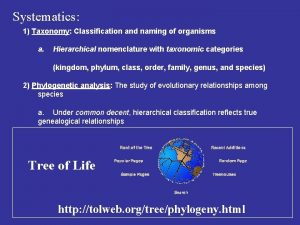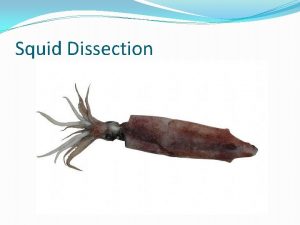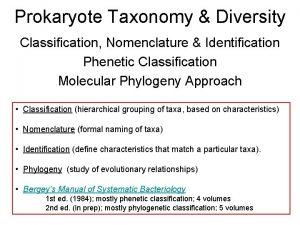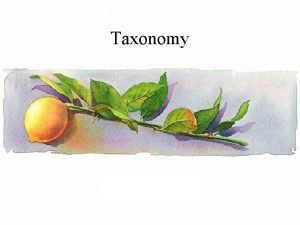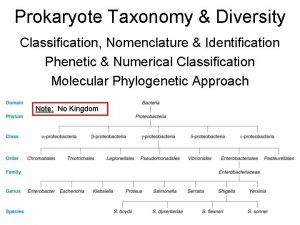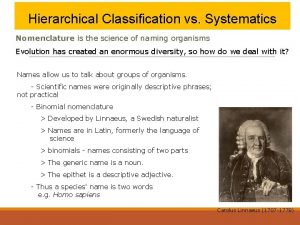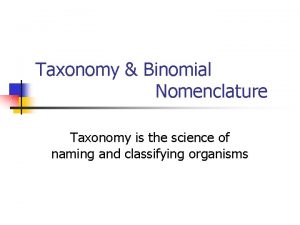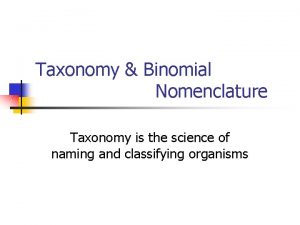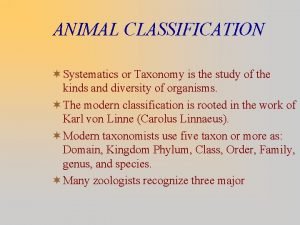Systematics Taxonomy Classification Identification or Determination Nomenclature Floristics






























- Slides: 30

Systematics

Taxonomy. Classification. Identification or Determination. Nomenclature-

Floristics. Examples: Manual of the Vascular Plants of Texas Shinners and Mahler’s Illustrated Flora of North Central Texas Flora of North America

Native. Introduced or exotic. Naturalized. Lonicera albiflora Torr. & Gray and L. sempervirens L. (red) are only native honeysuckles in our area. Three are perfoliate, whereas introduced species are not.

Primary goals of plant systematics: 1. Identify and describe all plants of world @_____ species of plants known. Many more undiscovered (15, 000 new species in South America alone). @_____ vascular plants in USA and Canada @_____ in Texas and 2223 in North Central Texas 2. Develop a uniform, practical, and stable system of naming plants that can be used by both plant taxonomists and others needing to communicate about plants International codes providesrules for naming and classification that is uniform and stable. Books and websites allow us to communicate (Appendix 5 and 11) 3. Form groups that reflect their evolutionary relationships

Taxa are grouped according to two main schools of taxonomists (Read Appendix 6 for details): 1. Traditional taxonomists -look at overall similarity or phenetics which may recognize paraphyletic groups like Asclepiadaceae and Reptiles (Fig. 39 And 40) -Cronquist System in Appendix 1 is a widely used traditional classification and uses monophyletic and paraphyletic groups


Monophyletic group-groups taxonomists try to form -give information that is critical for breeding programs and search for useful products Paraphyletic group-accepted by traditional taxonomist when group is phenetically different and can be identified by its morphology ex. Birds and Asclepidaceae. Polyphyletic group-taxonomist has made a mistake due to convergent evolution where species are not genetically closely related but have adapted to similar environments

Classic example of convergence in plants: Euphorbiaceae & Cactaceae

2. Cladists or phylogenetic classification -does not use binomial nomenclature or ranks -only examines the branching patterns of evolution using phylogenetic trees that reflect monophyletic groups -only recognizes monophyletic groups, so Asclepiadaceae becomes part of Apocynaceae and birds part of Reptilia (Figs. 39 and 40) -cladogram using DNA sequence data indicates that monocots are derived from within dicots making the dicot group paraphyletic (Fig. 41)



Apocynaceae (1900 species) Amsonia ciliata Walter Asclepiadaceae (2900 species with characteristics of Apocynaceae except all have corona and fused stamens and pistil) Asclepias viridiflora Raf.


After grouping is complete, ranks are assigned. Ranks used in the Taxonomic Hierarchy ____________ -plants have eukaryotic cells and are in Domain Eukaryota Kingdom -members of the Kingdom Plantae, photosynthesize, have tissues, and undergo alternation of generations. ____________ -groups of classes -international rules specify that it must end in -phyta Bryophyta, Anthoceratophyta, Marchantiophyta (Hepatophyta), Lycopodiophyta, Psilotophyta, Equisetophyta, Polypodiophyta, Cycadophyta, Ginkgophyta, Pinophyta, Gnetophyta, and Magnoliophyta are the 12 divisions of plants

___________ -groups of subclasses and orders -international rules specify an -opsida ending -Magnoliopsida (Dicots) and Liliopsida (monocots) are the two classes of Magnoliophtes (Anthophytes or Angiosperms) Subclass -groups of orders that end in -idea -Cronquist system contains 11 subclasses and is widely used and presented in Appendix 1 Order -groups of families that end in -ales

__________ -groups of subfamilies, tribes, or genera that end in -aceae -387 -685 depending on classification system with 149 in North Central Texas Eight families may have endings other than -aceae: Name Modern Name Common Name Palmae Palm Cruciferae Mustard Umbelliferae Carrot Labiatae Mint Graminae Grass Leguminosae Pea Compositae Sunflower Guttiferae Clusiaceae St. John’s Wort

Subfamily -groups of tribes or genera in large families that ends in -oideae -One example is the Grass family in Appendix 2 Tribe -groups of genera in large families that end in -eae -One example is the Grass family in Appendix 2 and Asteraceae on Page 298 Genus (Genera) -groups of one (monotypic Ex. Ginkgo biloba) to several species (large one is Quercus (oaks) with 400 species worldwide) -first part of binomial scientific name with no set ending -may be divided into sections or subgenera in a large genus

Species -the second part of a binomial scientific name often called the species epithet with no set ending; basic unit of classification -may not be used alone as must accompany a genus name. When the genus name is written once in a document, it may be abbreviated-Q. fusiformis Small (liveoak)

Why use scientific names instead of common names? 1) Common names are not______, scientific names are. 2) Common names give no information about generic relationships For example cottonwoods and aspens are both close relatives and in the same genus, Populus. You may have known these common names but not realized they were related. 3) Plants often have more than one _______name. Populus deltoides Bartram ex Marshall subsp. deltoides is called eastern cottonwood and alamo.

4) Several plants may have the same common name. For example 100 s of different plants are referred to as sunflowers 5) Many plants do not have a common name. Cyperus setigerus Torr. & Hook 6) Common names may be _______. For example live oak and poison-oak are in two very different families.

Scientific or botanical names were originally polynomials that were a brief description of the plant in Latin. These were eventually all changed to binomial nomenclature by Linnaeus. For example, one species of buttercup was called Ranunculus calycibus retroflexis, pedunculis falcatis, caule erecto, foliis compositis which means the buttercup with bent-back sepals, curved flower stalks, erect stems, and compound leaves

Complete Scientific Name consists of three parts: 1) Generic name-Latin name beginning with a capital letter that is italicized or underlined; if species is unknown can substitute sp. (singular) or spp. (plural). Uninomial- Quercus sp. 2) Specific name or species epithet-Latin name beginning with a lowercase letter that is italicized or underlined that is always used with a genus name. Binomial- Q. fusiformis (liveoak) 3) Authority-indicates the scientist that named a particular taxon. Never italicized or underlined and often abbreviated- Q. fusiformis Small

Three intraspecific or infraspecific taxa are trinomials 1) Subspecies-populations within a species that have a regional range with distinctive morphological characteristics -only intraspecific taxon used by zoologists and favored by modern plant systematists Example: Populus deltoides Bartram ex Marshall (cottonwood) P. deltoides subsp. deltoides -leaf blade 10 -20 teeth on each side, E. 1/2 Texas to Wichita Falls P. deltoides subsp. monilifera (Aiton) Eckenw. -leaf blade with 5 -10 teeth on each side, Panhandle S & E to Eastland County in our area Pg. 975 -977 SMIFNCT

2) Variety-populations within a species or subspecies with minor morphological variation and a local range -sometimes varieties are treated in the same sense as subspecies Example: Cercis canadensis L. var. canadensis (usually single trunked, etc. (Pg. 640) in stream bottoms and lower slopes in sand or silt) and C. canadensis L. var. texensis (S. Watson) M. Hopkins (usually multi-trunked, etc. on rocky limestone slopes)

3) forma-lowest category in the taxonomic hierarchy that is differentiated by minor variation. -rarely used today and is not used in SMIFNCT Miscellaneous Names: 1) Cultivars-cultivated form of some native species distinguished by any characteristics and propagated by any means -not a taxonomic category, used in horticulture -not governed by international codes botanical nomenclature but by rules of cultivated plants -written with an initial capital letter and uses a modern language -indicated by cv. or single quotation marks Ex. Citrus limon cv. Sugardaddy or C. limon ‘Sugardaddy’

2) Hybrids-parental names connected by an X or an X in front of a collective name Example Baptisia Xbicolor Greenm. & Larisey [B. australis X B. bracteata] Pg. 80 SMIFNCT B. australis

International Code of Botanical Nomenclature (ICBN) is now IC of Nomenclature for algae, fungi, and plants (ICNAFP) Names follow rules of international codes, which include six principles: 1) Botanical nomenclature is independent of zoological nomenclature. Names used in classification may overlap. 2) Botanical names are represented by types. Types are specimens designated by botanist that names a new species. They legally represent the name of the species and provide the original material used in its description. 3) Each taxonomic group has only one name. 4) Scientific names are treated in Latin. International Code of Botanical Nomenclature was revised and Latin is no longer required.

ICNAFP principles (cont. ): 5) Nomenclature is based on priority of publication. -way to determine acceptance when there are two or more names for the same taxon -oldest validly published name is correct starting with Species Plantarum, a book written by Linnaeus in 1753, and working your way forward through the literature Two consequences of principle of priority 1. Double Citation-indicates a change in rank and includes the original authority name in parentheses, for example Cercis canadensis L. var. texensis (S. Watson) M. Hopkins 2. Synonyms-two or more names apply to the same taxon Chelone obliqua L. Systema Vegetabili, ed. XII. p. 408. 1767. Chelone purpurea Miller's Garden Dictionary, ed XIII, n. 2. 1768. ---C. obliqua L. is accepted name based on priority. 6) Rules are retroactive, effecting rules prior to enactment.

Naming a newly discovered plant: 1. Gather data to show that populations are different. 2. Name constructed according to international codes and never used before for a plant. 3. Clearly indicate its rank--Today usually new species or intraspecies. 3. Designate a type specimen from the collections that you use to obtain data. 5. Describe the taxon and provide illustrations or photographs. 6. Publish work in a peer-reviewed journal. Changing names as new data becomes available, can also occur. Names are hypotheses based on the data known at the time. Example: Nelson and Elisens article from American Journal of Botany http: //www. amjbot. org/cgi/content/full/86/10/1487? maxtoshow=&HITS=10&hits=10&RESULTFORMAT= Appendix 7 - Changes in the scientific names of plants
 Systematics vs taxonomy
Systematics vs taxonomy 0110001101
0110001101 Relay floristics
Relay floristics Traditional systematics
Traditional systematics Systematics deals with
Systematics deals with Modern systematics try to group organisms based on
Modern systematics try to group organisms based on Nomenclature in taxonomy
Nomenclature in taxonomy Marzano's taxonomy
Marzano's taxonomy Biochemical tests
Biochemical tests Central pocket whorl vs plain whorl
Central pocket whorl vs plain whorl Most specific level of classification
Most specific level of classification Classification dichotomous key
Classification dichotomous key Horse class taxonomy
Horse class taxonomy Dichotomous key animals
Dichotomous key animals Squid taxonomy classification
Squid taxonomy classification Domain of mushroom
Domain of mushroom X-ray structure determination
X-ray structure determination Coefficient of determination interpretation
Coefficient of determination interpretation Blank determination example
Blank determination example Sex linkage
Sex linkage Brainpop sex ed
Brainpop sex ed Advanced higher biology unit 2
Advanced higher biology unit 2 Self advocacy worksheets
Self advocacy worksheets What is a sample size
What is a sample size Shipping point determination
Shipping point determination Shipping point determination sap
Shipping point determination sap R squared interpretation
R squared interpretation Requirement determination
Requirement determination Coefficient of determination in r
Coefficient of determination in r Quality determination
Quality determination Bicinchoninic acid
Bicinchoninic acid

